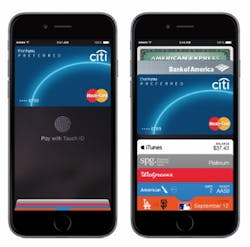This week Apple, Inc. unveiled its new iPhone 6 and iPhone 6 Plus in an extravagant affair at the Flint Center in Cupertino, CA. The new iPhones are sleek. They are 4.7 inches and 5.5 inches respectively and are much larger, thinner and faster than today’s iPhone 5s. But one of the biggest features of the new phone, especially as it relates to vending, is its ability to now support near field communication (NFC) mobile payments.
Apple Pay: How it works
In addition to launching a new phone, Apple introduced its new Apple Pay . Users can place their thumb on the Touch ID and the NFC antenna will transmit the payment from the phone to the merchant. Why is it different from other mobile wallets? Passbook, a feature on iPhones and iPods that lets users store movie tickets, boarding passes, etc., stores credit and debit cards, and like EMV, it does not store the actual card number. Instead, a unique Device Account Number is assigned, encrypted and securely stored in the Secure Element on the iPhone or Apple Watch. “Each transaction is authorized with a one-time unique number using your Device Account Number and instead of using the security code from the back of your card, Apple Pay creates a dynamic security code to securely validate each transaction,” Apple revealed in its press release.
The numbers
Mobile payments were slow to adoption when they came out in 2011 and 2012. Consumers raised concerns about security issues and unsatisfying infrastructure to mobile wallets. In its 2014 report, IDC Financial Insights found that this year mobile payments had reached a slow point of adoption, with only 37 percent of respondents reporting that they use mobile payments of some kind. And the research firm Gartner found that North American consumers spent $37 billion through mobile transactions in 2013, up $13 billion from the year before (which is a much smaller number than what other countries spend). Why? One reason, I believe, is that prior to Tuesday’s announcement, Apple phones did not support NFC payments and that meant there was a large population of consumers without access to NFC.
Why it matters
Now, Apple has answered many consumer concerns with their new launch of Apple Pay. Secure? Yep. Easy to use? Yep. Worth the while? Well, considering dozens of large companies like McDonald’s, Walgreens, Staples, Subway and Petco have already announced they will begin accepting mobile payments, I would say “yep” to that.
Statista reports that there are 63.2 million iPhone users in the U.S. alone and if any of them are like me, they are loyal and committed to using Apple products, and will upgrade to the newest iPhone whenever there is a chance. What does all of this mean? It means that Apple just opened up a huge customer base of potential NFC users.
Once users begin getting accustomed to paying for everyday items at their local grocery store, the mall and restaurants, I’m betting they will expect the same mobile payment experience on their vending machine or micro market. Many payment acceptors on vending machines and micro markets already have the ability to accept mobile payments using NFC, and to me, it’s clear that NFC will be the mobile payment of the future…at least until a new technology comes out to replace it.
About the Author

Adrienne Klein
Contributing Editor
Adrienne Zimmer Klein is a freelance writer with a background in the vending, micro market and office coffee service industry. She worked as an associate editor and managing editor at Automatic Merchandiser and VendingMarketWatch.com from 2013 until 2017. She is a regular contributing writer at Automatic Merchandiser.
